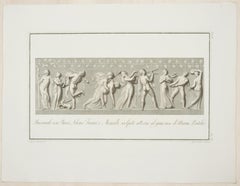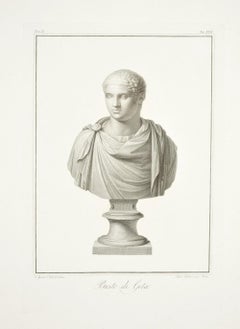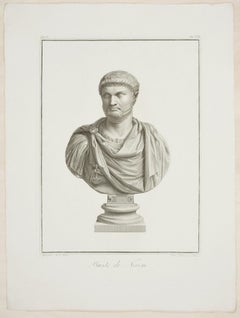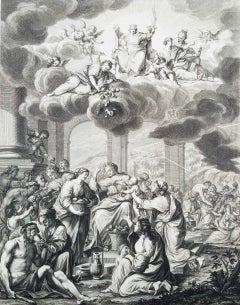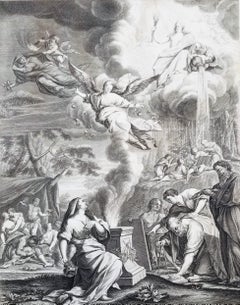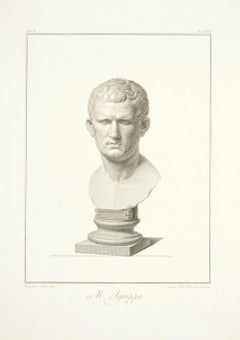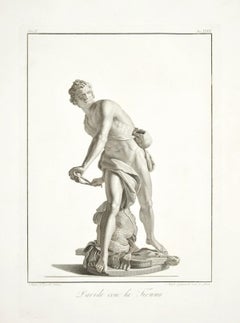Pietro Fontana Art
1762-1837
An Italian artist and engraver, Pietro Fontana was active in Rome and specialized in subjects dealing with the Vatican and the Papacy. He started his career as a student of Raffaello Morghen and is best known for his complete series of engravings of the neoclassical sculptures of Canova. He became a member of the Accademia di San Luca.
to
2
5
Overall Width
to
Overall Height
to
5
3
2
3
2
4
3
3
2
1
1
1
1
1
1
1
1
5
5
9,475
2,687
1,375
1,358
2
Artist: Pietro Fontana
Bacchanalia - Etching by P. Fontana After A. Tofanelli - 1821
By Pietro Fontana
Located in Roma, IT
“Baccanale con Bacco, Sileno, Fauni, e Menadi” is a beautiful black and white burin and etching on paper, realized by the Italian artist Pietro Fontana (Bassano Romano,1762 – Rome, ...
Category
1820s Modern Pietro Fontana Art
Materials
Etching
Bust of Geta - by P. Fontana - 1821
By Pietro Fontana
Located in Roma, IT
Image dimensions: 48.4 x 33.2 cm
Busto di Geta (Bust of Geta) is a superb black and white burin and etching on paper, realized by the artist Pietro Fontana, after Agostino Tofanelli, as the inscriptions on plate on the lower margin report “Agostino Tofanelli delineò / Pietro Fontana incise Roma”.
This original print is numbered on plate in Roman numerals on the higher margin: “Tom II. / Tav. XXII" and is a plate from the series "Illustrazioni de' Monumenti scelti Borghesiani già esistenti nella Villa sul Pincio (..) date ora per la prima volta in luce dal cav. Gio. Gherardo De Rossi e da Stefano Piale sotto la guida di Vincenzo Feoli", by Ennio Quirino Visconti, published by Stamperia de Romanis in Rome in 1821.
This old master’s original print shows a beautiful piece of the Borghese's collection: a marble bust of Geta in a neoclassical style. Geta (full name Publius Septimius Geta) was the son of Septimius Severus and Julia Domna, and the brother of Caracalla. He was a Roman co-emperor from 209 to 212 AD, first with his father and then with his brother. His biography is very interesting: he was the younger son of Septimius Severus and his second wife; his face was obliterated because of the damnatio memoriae ordered by his brother Caracalla, who had him assassinated.
In excellent conditions, with some light signs of time, some sporadic minor stains along the lower margin, and a usual and imperceptible yellowing of the paper on the margins. This wonderful etching has preserved its charming and fresh impression.
Pietro Fontana (Bassano Romano, 1762 – Rome, 1837)
The Italian artist and engraver Pietro Fontana was active in Rome and specialized in subjects dealing with the Vatican and the Papacy. He started his career as student of Raffaello Morghen...
Category
1820s Old Masters Pietro Fontana Art
Materials
Etching
$536 Sale Price
35% Off
Bust of Tiberius - Original Etching by P. Fontana After A. Tofanelli
By Pietro Fontana
Located in Roma, IT
“Tiberio con corona civica” (Tiberius with a civic crown) is a beautiful black and white burin and etching on paper, realized by the artist Pietro Fontana (Caslano 1763 – Rome 1829),...
Category
1820s Modern Pietro Fontana Art
Materials
Etching
Bust of Nero - Original Etching by P. Fontana After B. Nocchi - 1821
By Pietro Fontana
Located in Roma, IT
“Busto di Nerone” (Bust of Nerone) is a beautiful black and white burin and etching on paper, realized by the Italian artist Pietro Fontana, after Bernardino Nocchi as the inscriptions on plates on lower margins report “Bernardino Nocchi delineò./ Pietro Fontana incise Roma”.
This original print is numbered on plate in Roman numerals on higher margin: “Tom II. /Tav. XVII" and is a plate from the series "Illustrazioni de'Monumenti scelti Borghesiani già esistenti nella Villa sul Pincio (..)date ora per la prima volta in luce dal cav. Gio. Gherardo De Rossi e da Stefano Piale sotto la guida di Vincenzo Feoli", by Ennio Quirino Visconti, published by Stamperia de Romanis in Rome, 1821.
This old master’s original prints shows a precious piece of the Borghese's collection, the marble bust of the Roma Emperor, Nerone, realized with neoclassical style and a wise touch
In excellent conditions with some light signs of the time, with some sporadic minor stains along the margins above all on the lower, and a usual yellowing of the paper on the lower margin, this wonderful burin has preserved still today his fresh impression.
Illustrazioni de' Monumenti scelti Borghesiani
This collection in two volumes is a beautifully detailed catalog of classical sculptures collected by Prince Borghese (1730-1800) in his Villa on the Pincio. Ennio Quirino Visconti (1751 - 1818) wrote the texts that accompany the large branches depicting. To these writings, which were available by the son of the illustrious archaeologist, the publishers added only a few illustrations relating to some minor monument of which copper had already been engraved.
The engraved title-plate are signed by draughtsmen like Agostino Tofanelli, Stefano Tofanelli, Bernardino Nocchi, Domenico de Angelis or Teodoro Matteini, and by engravers Pietro Fontana Veneto, P. Vitali, Pietro Bettelini, Giovanni Folo Veneto, Giovanni Brunetti da Ravenna, Giovanni Ottaviani, Francesco Cecchini, Gio. Batta. Leonetti, Girolamo Carattoni, Domenico Cunego, Luigi Cunego, Alessandro Mochetti, Luigi Pizzi, Angelo Campanella or Giacomo Bossi.
The Volume I shows ancient full-length statues, of the Borghese warrior by Agasias (two plates), Greek gods and heroes and Roman famous historical figures; the last two plates represents antique Egyptian deities. There are plates representing ancient bas-reliefs, sarcophagi, of mythological subjects, the Borghese Vase, portrait busts, a vase on an altar, two statues of Amor; and two modern statues, by Bernini (the Apollo and Daphne, and the David).
«Très bel ouvrage» writes Brunet, «Grand ouvrage, le seul qui mérite, parmi ceux sur la villa Borgese, de figurer dans le chapitre aux Galeries et Collections» Vinet said, looking at this plate.
Pietro Fontana (Bassano Romano,1762 – Rome, 1837)
The Italian artist and engraver, Pietro Fontana was active in Rome and specialized in subjects dealing with the Vatican and the Papacy. He started his career as a student of Raffaello...
Category
1820s Modern Pietro Fontana Art
Materials
Etching
Ara con Tripode - Etching by V. Feoli After B. Nocchi - 1821
By Pietro Fontana
Located in Roma, IT
Image dimensions: 33.7 x 48.6 cm.
“Ara con tripode” (Ara with tripod) is a beautiful black and white burin and etching on paper, realized by the artist Vincenzo Feoli, after Bernardino Nocchi as the inscriptions on plates on lower margins report “Bernardino Nocchi delineò/ Vincenzo Feoli incise in Roma”.
This original print is numbered on plate in Roman numerals on higher margin: “Tom II. /Tav. XXVIII" and is a plate from the series "Illustrazioni de'Monumenti scelti Borghesiani già esistenti nella Villa sul Pincio (..)date ora per la prima volta in luce dal cav. Gio. Gherardo De Rossi e da Stefano Piale sotto la guida di Vincenzo Feoli", by Ennio Quirino Visconti, published by Stamperia de Romanis in Rome, 1821.
Original Title: Ara con Tripode di quindecemviri, e la corona...
Category
1820s Old Masters Pietro Fontana Art
Materials
Etching
$536 Sale Price
35% Off
Related Items
Meridies; Der Mittag (Noon; The Midday) /// Johann Daniel Preissler Old Master
Located in Saint Augustine, FL
Artist: (after) Johann Daniel Preissler (German, 1666-1737)
Title: "Meridies; Der Mittag (Noon; The Midday)"
Portfolio: Die Vier Tageszeiten (The Four Times of Day)
Year: 1723
Medium: Original Etching and Engraving on laid paper
Limited edition: Unknown
Printer: likely Johann Balthasar Probst, Augsburg, Germany
Publisher: Jeremias Wolff (Erben), Augsburg, Germany
Reference: Le Blanc No. 255, 38; Nagler No. 23
Sheet size: 22.5" x 16.32"
Image size: 18.13" x 14.32"
Condition: Soft handling creases and folds to sheet. A few light areas of staining and scattered small areas of discoloration in margins. Two small tears skillfully repaired from verso in margins. Has been professionally stored away for decades. It is otherwise a strong impression in good condition with full margins
Extremely rare
Notes:
Provenance: private collection - Aspen, CO. Engraved by German artist Johann Balthasar Probst (1673-1750) after a drawing by German artist Johann Daniel Preissler (1666-1737). Comes from Preissler's 1723 "Die Vier Tageszeiten (The Four Times of Day)" portfolio of four etchings and engravings. Printed from one copper plate in one color: black. Descriptions of the portrayed image are printed in Latin and German.
Biography:
Johann Daniel Preissler, or Preisler (1666–1737) was a German painter and director of Nuremberg's Academy of Fine Arts. He was a notable member of a German artistic family, originating in Bohemia. His children included Johann Justin Preissler (1698–1771), Georg Martin Preisler (1700–1754), Barbara Helena Preisler (1707–1758; married to Oeding), Johan Martin Preisler (1715–1794), and Valentin Daniel Preisler (1717–1765), all in their time renowned artists. Most notable for his portraits, nudes and history paintings, Johann Daniel Preissler also produced drawings and frescoes. He was particularly known beyond his native Nuremberg for his "Die durch Theorie erfundene Practic", a sequence of works on art theory – the individual works were translated into several other languages and served as textbooks for students such as the Swiss Salomon Gessner...
Category
1720s Old Masters Pietro Fontana Art
Materials
Laid Paper, Engraving, Etching
$900
H 22.5 in W 16.32 in
Aurora sive Tempus Matutinum; Der Wohl und Übel angewandte Morgen /// Old Master
Located in Saint Augustine, FL
Artist: (after) Johann Daniel Preissler (German, 1666-1737)
Title: "Aurora sive Tempus Matutinum; Der Wohl und Übel angewandte Morgen (Dawn or Morning Time; The Morning Used for Better or For Worse)"
Portfolio: Die Vier Tageszeiten (The Four Times of Day)
Year: 1723
Medium: Original Etching and Engraving on laid paper
Limited edition: Unknown
Printer: likely Johann Balthasar Probst, Augsburg, Germany
Publisher: Jeremias Wolff (Erben), Augsburg, Germany
Reference: Le Blanc No. 255, 38; Nagler No. 23
Sheet size: 22.57" x 16.38"
Image size: 17.75" x 14"
Condition: Soft handling creases, folds, and scattered faint areas of discoloration to sheet. Three tears skillfully repaired from verso. Has been professionally stored away for decades. It is otherwise a strong impression in good condition with full margins
Extremely rare
Notes:
Provenance: private collection - Aspen, CO. Engraved by German artist Johann Balthasar Probst (1673-1750) after a drawing by German artist Johann Daniel Preissler (1666-1737). Comes from Preissler's 1723 "Die Vier Tageszeiten (The Four Times of Day)" portfolio of four etchings and engravings. Printed from one copper plate in one color: black. Descriptions of the portrayed image are printed in Latin and German.
Biography:
Johann Daniel Preissler, or Preisler (1666–1737) was a German painter and director of Nuremberg's Academy of Fine Arts. He was a notable member of a German artistic family, originating in Bohemia. His children included Johann Justin Preissler (1698–1771), Georg Martin Preisler (1700–1754), Barbara Helena Preisler (1707–1758; married to Oeding), Johan Martin Preisler (1715–1794), and Valentin Daniel Preisler (1717–1765), all in their time renowned artists. Most notable for his portraits, nudes and history paintings, Johann Daniel Preissler also produced drawings and frescoes. He was particularly known beyond his native Nuremberg for his "Die durch Theorie erfundene Practic", a sequence of works on art theory – the individual works were translated into several other languages and served as textbooks for students such as the Swiss Salomon Gessner...
Category
1720s Old Masters Pietro Fontana Art
Materials
Laid Paper, Engraving, Etching
$900
H 22.57 in W 16.38 in
Vespera; Der Abend (Evening; The Evening) /// Johann Daniel Preissler Old Master
Located in Saint Augustine, FL
Artist: (after) Johann Daniel Preissler (German, 1666-1737)
Title: "Vespera; Der Abend (Evening; The Evening)"
Portfolio: Die Vier Tageszeiten (The Four Times of Day)
Year: 1723
Medium: Original Etching and Engraving on laid paper
Limited edition: Unknown
Printer: likely Johann Balthasar Probst, Augsburg, Germany
Publisher: Jeremias Wolff (Erben), Augsburg, Germany
Reference: Le Blanc No. 255, 38; Nagler No. 23
Sheet size: 22.5" x 16.63"
Image size: 17.38" x 13.63"
Condition: Soft handling creases and folds to sheet. Some scattered foxmarks in left margin. Two small tears skillfully repaired from verso in margins. Has been professionally stored away for decades. It is otherwise a strong impression in good condition with full margins
Extremely rare
Notes:
Provenance: private collection - Aspen, CO. Engraved by German artist Johann Balthasar Probst (1673-1750) after a drawing by German artist Johann Daniel Preissler (1666-1737). Comes from Preissler's 1723 "Die Vier Tageszeiten (The Four Times of Day)" portfolio of four etchings and engravings. Printed from one copper plate in one color: black. Descriptions of the portrayed image are printed in Latin and German.
Biography:
Johann Daniel Preissler, or Preisler (1666–1737) was a German painter and director of Nuremberg's Academy of Fine Arts. He was a notable member of a German artistic family, originating in Bohemia. His children included Johann Justin Preissler (1698–1771), Georg Martin Preisler (1700–1754), Barbara Helena Preisler (1707–1758; married to Oeding), Johan Martin Preisler (1715–1794), and Valentin Daniel Preisler (1717–1765), all in their time renowned artists. Most notable for his portraits, nudes and history paintings, Johann Daniel Preissler also produced drawings and frescoes. He was particularly known beyond his native Nuremberg for his "Die durch Theorie erfundene Practic", a sequence of works on art theory – the individual works were translated into several other languages and served as textbooks for students such as the Swiss Salomon Gessner...
Category
1720s Old Masters Pietro Fontana Art
Materials
Laid Paper, Engraving, Etching
$900
H 22.5 in W 16.63 in
The Academy of Plato Plato and His Disciples
By Salvator Rosa
Located in Fairlawn, OH
The Academy of Plato
Plato and His Disciples
Etching and drypoint
c. 1662, printed c. 1710
Signed in the plate lower left
Inscribed lower left: 'In villa ab Academo attributa sua[m]...
Category
1660s Old Masters Pietro Fontana Art
Materials
Etching
$750
H 18.19 in W 10.75 in
The Crucifixion (Christ on the Cross) /// Jesus after Albrecht Dürer Old Masters
Located in Saint Augustine, FL
Artist: Lambrecht Hopfer (German, Active c. 1525-1550)
Title: "The Crucifixion (Christ on the Cross)"
Portfolio: (after) The Engraved Passion
*Issued unsigned, though monogram signed by Hopfer in the plate (printed signature) lower right
Circa: 1530 (second state of three, published c. 1690)
Medium: Original Etching on laid paper
Limited edition: Unknown
Printer: The Hopfer family, Augsburg, Germany; (David Funck, Nuremberg, Germany)
Publisher: The Hopfer family, Augsburg, Germany; (David Funck, Nuremberg, Germany)
Reference: Bartsch No. VIII.527.12; Hollstein No. 12.II
Framing: Recently framed, the sheet is floated over, and top-matted with a 100% cotton fabric rag mat from Holland in a wood moulding and Museum glass
Framed size: 14.88" x 13.88"
Sheet size: 5.5" x 3.63"
Condition: Trimmed to platemark. A few tiny professional repairs: at elbow of Jesus's right arm and the inside thigh of Jesus. Some light skinning upper right corner and lower right area. It is otherwise a strong impression in good condition
Very rare
Notes:
Provenance: private collection - Green Bay, WI; acquired from Sotheby's, New York, NY in c. 2015. The artist Lambrecht Hopfer's printed monogram signature "LH" lower right. The printer/publisher David Funck's (plate) number "182" lower right. This etching is after Albrecht Dürer’s 1511 engraving "The Crucifixion (Christ on the Cross)", ("Dürer-Katalog" - Meder No. 13, page 73). Printed in black from an iron plate. The image depicts Christ on the cross at center, the Virgin at left, two Maries behind her, St. John standing at right, a Roman solider behind him. It is after the eleventh plate of Dürer's sixteen plates from his 1507-1513 "The Engraved Passion" series, ("Dürer-Katalog" - Meder No. 3-18, page 70-74).
"The print was originally designed without the number engraved in the lower margin (First state: Lambrecht Hopfer, c. 1530). The Hopfers' descendant David Funck (Nuremberg, 1642–1705) acquired over two hundred of their original iron plates, engraved numbers into them, and re-printed them around 1686-1700. The "182" indicates that "The Crucifixion" was the 182nd print in Funck’s series (Second state: David Funck, c. 1686-1700). About a century later, 92 of these plates were acquired by Carl Wilhelm Silberberg in Frankfurt and printed for the third and final time in the book "Opera Hopferiana", of which "The Crucifixion" was the 90th print (Third state: Carl Wilhelm Silberberg for "Opera Hopferiana", 1802)". - Elizabeth Upper, Cambridge University Library, University of Cambridge, Cambridge, UK
Biography:
Lambrecht (Lambert) Hopfer (Active c. 1525-1550) was a German Old Masters printmaker. He was the brother of Hieronymus Hopfer (Active c. 1520-1530) and son of Daniel Hopfer...
Category
16th Century Old Masters Pietro Fontana Art
Materials
Etching, Laid Paper
Inside the castle by David Hockney (Six Fairy Tales from the Brothers Grimm)
By David Hockney
Located in New York, NY
From David Hockney’s celebrated Six Fairy Tales from the Brothers Grimm portfolio, an image of the story ‘The boy who left home to learn fear’. Hockney chose this story for its obscu...
Category
1960s Modern Pietro Fontana Art
Materials
Etching, Aquatint
$2,250
H 17.75 in W 16 in
Four Figures and a Head, on Giant Phallus by Claes Oldenburg erotic nude scene
By Claes Oldenburg
Located in New York, NY
This sensuous and playful scene is characteristic of Oldenburg’s printmaking ouevre: a veritable heap of women displaying various expressions of joy and come-hither coquettishness. T...
Category
1970s Modern Pietro Fontana Art
Materials
Etching
The New Pupil /// Antique Modern Female Artist Etching Child Children Figurative
By Eileen Soper
Located in Saint Augustine, FL
Artist: Eileen Alice Soper (English, 1905-1990)
Title: "The New Pupil"
*Signed by Soper in pencil lower right
Year: 1925
Medium: Original Etching on unbranded white wove paper
Limite...
Category
1920s Modern Pietro Fontana Art
Materials
Etching, Intaglio
Rapunzel, Rapunzel, let down your hair David Hockney Brothers Grimm Fairy Tales
By David Hockney
Located in New York, NY
From David Hockney’s celebrated Six Fairy Tales from the Brothers Grimm portfolio, an image from the story of Rapunzel, which he chose for its popularity. When illustrating the princ...
Category
1960s Modern Pietro Fontana Art
Materials
Etching, Aquatint
Old Rinkrank threatens the Princess by David Hockney Brothers Grimm Fairy Tales
By David Hockney
Located in New York, NY
This etching from David Hockney’s celebrated Six Fairy Tales from the Brothers Grimm portfolio depicts the somewhat obscure story Old Rinkrank, which Hockney chose to illustrate beca...
Category
1960s Modern Pietro Fontana Art
Materials
Etching, Aquatint
Catherina Dorothea Viehmann David Hockney Fairy Tales from the Brothers Grimm
By David Hockney
Located in New York, NY
The frontispiece for Hockney’s Six Fairy Tales from the Brothers Grimm portfolio and book features Catherina Dorothea Viehmann, the elderly German woman who recounted fairy tales to ...
Category
1960s Modern Pietro Fontana Art
Materials
Etching, Aquatint
$850
H 24.75 in W 17.75 in
The Roman Colosseum: A Framed 18th Century Etching of the Interior by Piranesi
By Giovanni Battista Piranesi
Located in Alamo, CA
This large framed 18th century etching by Giovanni Battista Piranesi entitled "Veduta dell'interno dell'Anfiteatro Flavio detto il Colosseo" (View of the interior of the Flavian Amph...
Category
1760s Old Masters Pietro Fontana Art
Materials
Etching
$4,700 Sale Price
20% Off
H 28.88 in W 37.25 in D 1.25 in
Previously Available Items
Bust of M. Agrippa - by G. Foto After B. Nocchi - 1821
By Pietro Fontana
Located in Roma, IT
Image dimensions: 49x33.4 cm
M. Agrippa is a beautiful black and white burin and etching on paper, realized by the Italian artist Giovanni Folo Veneto, after Bernardino Nocchi as the inscriptions on plates on the lower margins report “Bernardino Nocchi delineò. / Giovanni Folo Veneto incise in Roma”.
This original print is numbered on plate in Roman numerals on the higher margin: “Tom II. / Tav. XXIII" and is a plate from the series "Illustrazioni de' Monumenti scelti Borghesiani già esistenti nella Villa sul Pincio (..) date ora per la prima volta in luce dal cav. Gio. Gherardo De Rossi e da Stefano Piale sotto la guida di Vincenzo Feoli" by Ennio Quirino Visconti, published by Stamperia de Romanis in Rome in 1821.
This old master’s original print shows a precious piece of the Borghese's collection, the marble bust of Marco Vipsanio Agrippa (Arpino, 63 BC approx. - Campania, 12 BC), a Roman politician, military and architect but above all a friend of Octavian, the future Emperor Augustus and also his faithful collaborator and son-in-law. Agrippa was the author of many Octavian's military triumphs, the most notable of which was the naval victory in the battle of Actium against the forces of Mark Antony and Cleopatra.
In excellent conditions, with some light signs of the time and some sporadic minor stains along the margins, this wonderful burin has preserved still today its fresh impression.
Illustrazioni de' Monumenti scelti Borghesiani
This print collection in two volumes is a beautiful detailed catalog of classical sculptures collected by Prince Borghese (1730-1800) in his villa on the Pincio, in Rome. Ennio Quirino Visconti (1751 - 1818) wrote the texts that accompany the large illustrated plates. To these writings, which were found and made available by the son of the illustrious archaeologist, the publishers added - as they notified in the warning - only a few illustrations relating to some minor monuments formerly engraved on copper.
The Volume I shows ancient full-length statues of the Borghese warrior...
Category
1820s Old Masters Pietro Fontana Art
Materials
Etching
H 23.39 in W 17.33 in D 0.04 in
David with the Sling - Etching by A. Campanella After S. Tofanelli - 1821
By Pietro Fontana
Located in Roma, IT
Image dimensions: 39.5 x 31 cm
“Davide con la Fionna” (David with the sling) is a beautiful black and white burin and etching on paper, realized by the artist Angelo Campanella, after Stefano Tofanelli, as the inscriptions on plates on lower margins report “Stefano Tofanelli delineò/ Angelo Campanella incise in Roma”.
This original print is numbered on plate in Roman numerals on higher margin: “Tom II. /Tav. XXXII" and is a plate from the series "Illustrazioni de'Monumenti scelti Borghesiani già esistenti nella Villa sul Pincio (..)date ora per la prima volta in luce dal cav. Gio. Gherardo De Rossi e da Stefano Piale sotto la guida di Vincenzo Feoli", by Ennio Quirino Visconti, published by Stamperia de Romanis in Rome, 1821.
This old master’s original prints shows a beautiful piece of the Borghese's collection, the statue representing the young boy who with a sling defeated the monster Goliath and became a myth.
In excellent conditions with some light signs of the time with some sporadic minor stains along the higher margins, a usual yellowing of the paper at the edges, this wonderful etching has preserved still today his beauty and his fresh impression.
Illustrazioni de' Monumenti scelti Borghesiani
This collection in two volumes is a beautifully detailed catalog of classical sculptures collected by Prince Borghese (1730-1800) in his Villa on the Pincio. Ennio Quirino Visconti (1751 - 1818) wrote the texts that accompany the large branches depicting. To these writings, which were available by the son of the illustrious archaeologist, the publishers added only a few illustrations relating to some minor monument of which copper had already been engraved.
The engraved title-plate are signed by draughtsmen like Agostino Tofanelli, Stefano Tofanelli, Bernardino Nocchi, Domenico de Angelis or Teodoro Matteini, and by engravers Pietro Fontana Veneto, P. Vitali, Pietro Bettelini, Giovanni Folo Veneto, Giovanni Brunetti da Ravenna, Giovanni Ottaviani, Francesco Cecchini, Gio. Batta. Leonetti, Girolamo Carattoni, Domenico Cunego, Luigi Cunego, Alessandro Mochetti, Luigi Pizzi, Angelo Campanella or Giacomo Bossi.
The Volume I shows ancient full-length statues, of the Borghese warrior by Agasias (two plates), Greek gods and heroes and Roman famous historical figures; the last two plates represents antique Egyptian deities. There are plates representing ancient bas-reliefs, sarcophagi, of mythological subjects, the Borghese Vase, portrait busts, a vase on an altar, two statues of Amor; and two modern statues, by Bernini (the Apollo and Daphne, and the David).
«Très bel ouvrage» writes Brunet, «Grand ouvrage, le seul qui mérite, parmi ceux sur la villa Borgese, de figurer dans le chapitre aux Galeries et Collections» Vinet said, looking at this plate.
Angelo Campanella (Rome, 1748 – 1815)
Angelo Campanella was an Italian painter and engraver, learned his art under Giovanni Volpato. He engraved the statues of twelve apostles found in the church of St. John Lateran in Rome, and some of the plates for Gavin Hamilton's Schola Itálica including The Presentation in the Temple after Fra Bartolommeo...
Category
1820s Old Masters Pietro Fontana Art
Materials
Etching
H 23.23 in W 17.33 in D 0.04 in
Pietro Fontana art for sale on 1stDibs.
Find a wide variety of authentic Pietro Fontana art available for sale on 1stDibs. You can also browse by medium to find art by Pietro Fontana in etching and more. Much of the original work by this artist or collective was created during the 19th century and is mostly associated with the Old Masters style. Not every interior allows for large Pietro Fontana art, so small editions measuring 18 inches across are available. Customers who are interested in this artist might also find the work of Francesco Cecchini, Carle Vernet (Antoine Charles Horace Vernet), and Crispin de Passe II. Pietro Fontana art prices can differ depending upon medium, time period and other attributes. On 1stDibs, the price for these items starts at $624 and tops out at $891, while the average work can sell for $780.
